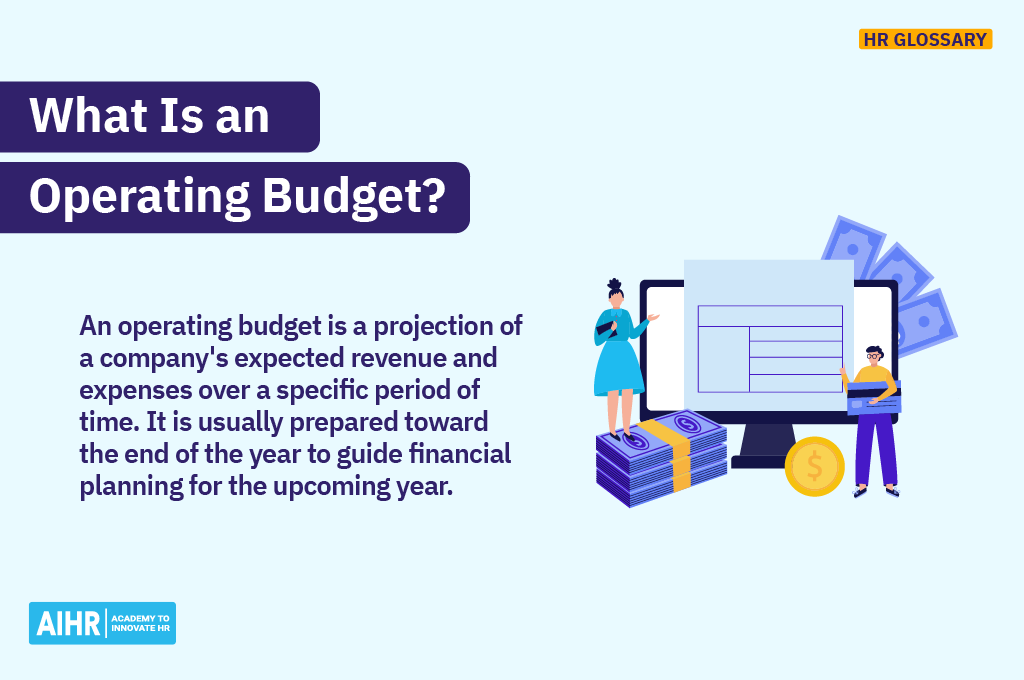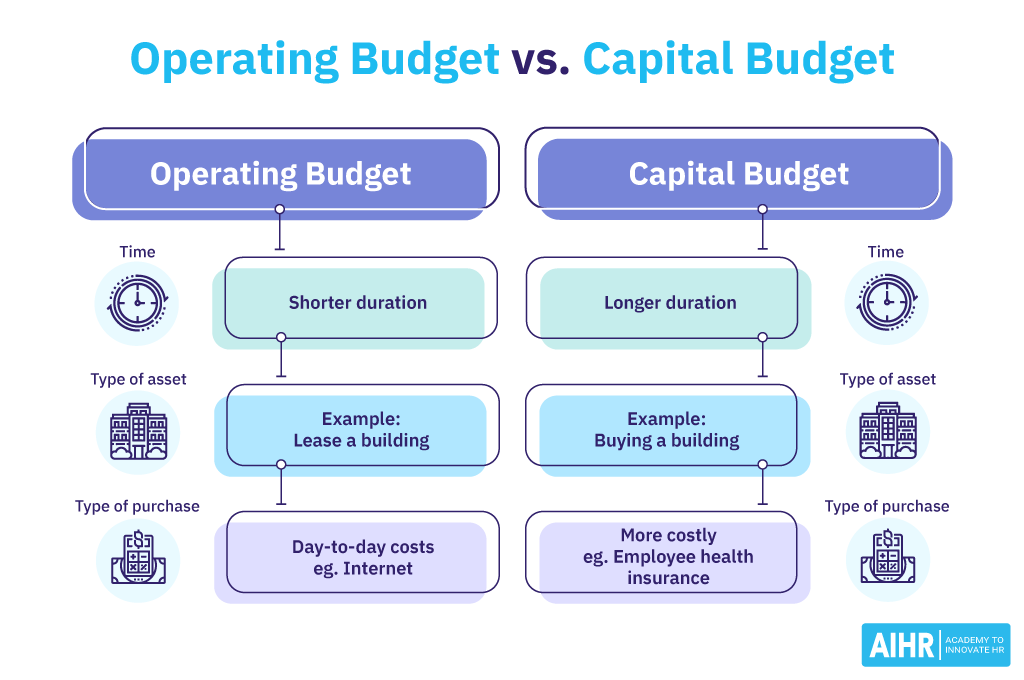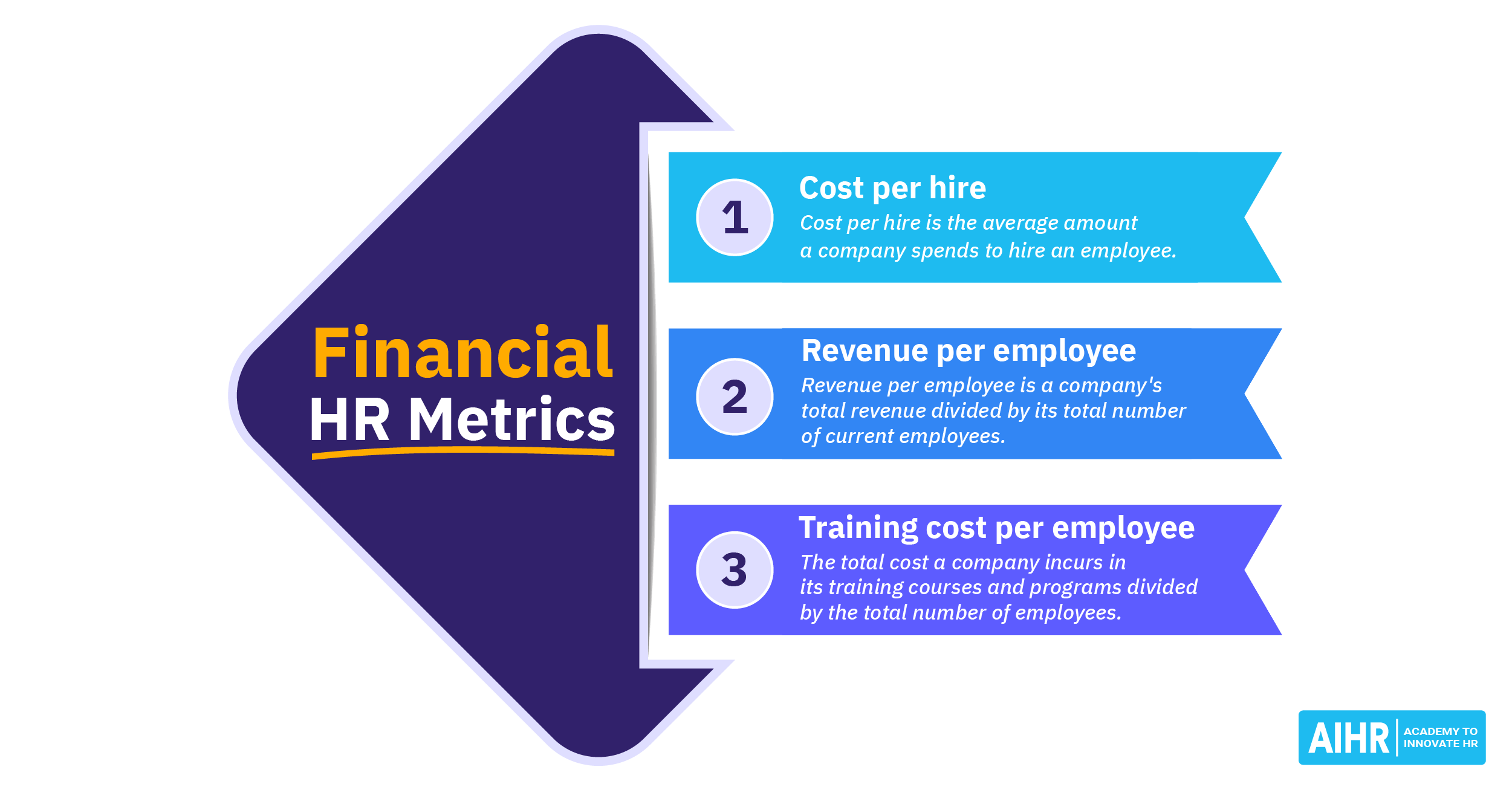Operating Budget
What is an operating budget?
An operating budget is a comprehensive estimate of an organization’s revenue and expenses over a specified period of time, typically a fiscal year. It outlines expected income from sales or services and the costs associated with running the business, such as salaries, rent, utilities, and materials.
This type of budget helps companies plan day-to-day operations and monitor financial performance, making it easier to stay on track with economic goals. For example, as an HR Manager, you can use it to assess your department’s performance by comparing the actual results to the operating budget.
The information obtained can help you determine:
- Whether the estimates need adjustments
- If the revenues are more or less as estimated
- Any unexpected expenses.

What is an annual operating budget?
As the name suggests, an annual operating budget is a detailed statement of an organization’s estimated revenue and expenses over a year. The budget acts as a reference point for all your activities over the next twelve months.
Annual operating budgets help managers make informed decisions during tough financial times, such as unexpected expenses or an economic downturn.
Components of an operating budget
An operating budget must be as detailed as possible to be more valuable and relevant. In most instances, the budget may have an overall summary with other supporting sub-budgets that offer more details. Generally, it should have these components:
- Revenue: This shows the different ways an organization generates money by offering services or selling goods. Although the projected revenue may be annual, breaking it down further into individual components, like average or unit price, makes the budget more insightful.
- Variable cost: This refers to expenses that fluctuate and impact revenues. Costs such as raw materials, sales commissions, freight, and labor fall under this category.
- Fixed cost: These are expenses that must be paid whether sales increase, decrease, or remain fairly constant. Examples include insurance, rent, and equipment leases.
- Non-cash expenses: These are expenses that typically have no impact on cash flow but will affect the company’s financial reporting performance at the end of the year. They include costs such as depreciation, deferred income taxes, stock-based compensations, and amortization.
- Non-operating expenses: This refers to expenses not directly linked to an organization’s main activity. They include gains or losses, interest, and taxes.
Operating budget example
Here’s an example of an operating budget summary for a fictional company:
Revenue
Sales
$500,000
Other income
$20,000
Total revenue
$520,000
Expenses
Salaries & wages
$200,000
Rent
$50,000
Utilities
$10,000
Marketing
$30,000
Office supplies
$5,000
Miscellaneous
$5,000
Total expenses
$300,000
Operating profit
$220,000
This basic example shows revenue and common operating expenses. The difference between total revenue and total expenses gives the operating profit, which reflects how much the company expects to make after covering its core operational costs for the quarter.
Why should companies make an operating budget?
An operating budget is essential for companies because it helps them manage their resources effectively. Here are other reasons why it’s important:
- Financial planning: It provides a roadmap for expected revenue and expenses over a set period, helping companies align their spending with their goals.
- Cost control: This budget identifies areas where costs might rise unexpectedly, allowing for early intervention to prevent overruns.
- Performance monitoring: Comparing actual performance to the budget lets companies track their progress and adjust strategies as needed.
- Resource allocation: An operating budget ensures funds are available for critical operations, helping prioritize projects that drive business growth.
- Informed decision-making: With a budget, management can make more informed decisions about scaling, hiring, investments, or cost-cutting while remaining financially sustainable.
Build smarter operating budgets with data-driven strategies
An operating budget outlines your department’s financial plan, helping manage revenue and expenses efficiently. Understanding how to create and monitor this budget is crucial for aligning HR activities with broader company goals.
With AIHR’s HR Metrics and Dashboarding Certificate Program, you’ll learn to develop, analyze, and visualize key metrics, empowering you to make informed budgeting decisions that drive success. Start optimizing your HR financial strategy today!
Capital budget vs. operating budget
A capital budget is a detailed financial plan of all the long-term capital expenses an organization expects. This includes investments in property, stocks, or new equipment. Capital budgets enable organizations to monitor their spending and ensure they have enough money to meet upcoming expenses.
Here are other major differences between operational budgets and capital budgets:
1. Duration
Operational budgets usually have shorter durations than capital budgets. For example, software programs that require monthly or yearly subscriptions are part of a company’s operational budgets, while costs such as the cost of an office building take longer to pay off and would, therefore, fall under the capital budget.
2. Type of asset
How your organization intends to acquire an asset can determine whether it’s part of its operational or capital budget. For example, leasing office space would fall under the operational budget, but purchasing it is considered a capital expense.
3. Type of purchase
Operational budgets include purchased items or services that make daily operations easier and more productive, like company cell phones and office WiFi.
Capital budgets, on the other hand, help create a healthy working environment and are included in the organization’s overall expenses. For example, items such as computers and health insurance cover fall under capital budgets.

How to create an operating budget
When creating an operating budget, there are some factors to consider:
- Know the revenue: It’s important to list all sources of income in your organization. has. This will help you get a clear picture of the entire monthly, quarterly, or yearly revenue.
- Look at the variables: Examine what could affect incoming sales. Some factors to consider include changing trends in your industry, new products the company intends to launch, economic changes, competition, and seasonal changes in sales, if any.
- Calculate expenses: List all your expenses and run the figures to estimate your costs. An HR operating budget may include costs such as recruitment expenses, replacing old tablets or laptops, changing benefits, and more.
Human resources are a critical department in any organization. HR teams play key roles, from handling recruitment and payroll to managing employee relations. This is why managing all these functions costs money. As an HR professional, it’s crucial to know how much money your department needs and how to apportion it. Understanding an operating budget and how it’s prepared can help you avoid making costly mistakes.
HR tip
Creating an operating budget for any organization is a collaborative effort that brings onboard executives and managers. As an HR Manager, you are responsible for developing a budget for your department. This budget will ultimately add up to the final budget of the organization. Knowing how to create an HR budget is, therefore, extremely crucial.
FAQ
An operating budget is a financial plan that outlines a company’s expected revenues and expenses for a specific period, typically one year. It includes projections for sales, production costs, operating expenses, and net income, helping businesses manage day-to-day operations and track financial performance.
The three types of expenses that should be listed in an operating budget are:
1. Fixed expenses: Costs that remain consistent over time, such as rent, salaries, and insurance.
2. Variable expenses: Costs that fluctuate with business activity, like utilities, materials, and sales commissions.
3. Semi-variable expenses: Costs that have both fixed and variable components, such as employee overtime or phone bills that include a base fee plus usage charges.
To plan an operating budget, start by reviewing past financial data to estimate future income and expenses. Break down costs into categories like fixed (e.g., rent, salaries) and variable (e.g., utilities, supplies). Estimate revenue based on expected sales or services. Consider any new initiatives or changes that could affect your financial outlook. Then, compare projected expenses against projected revenue to ensure the budget is balanced. Adjust as necessary to avoid overspending while meeting business goals. Regularly monitor and update the budget throughout the year to stay on track.









